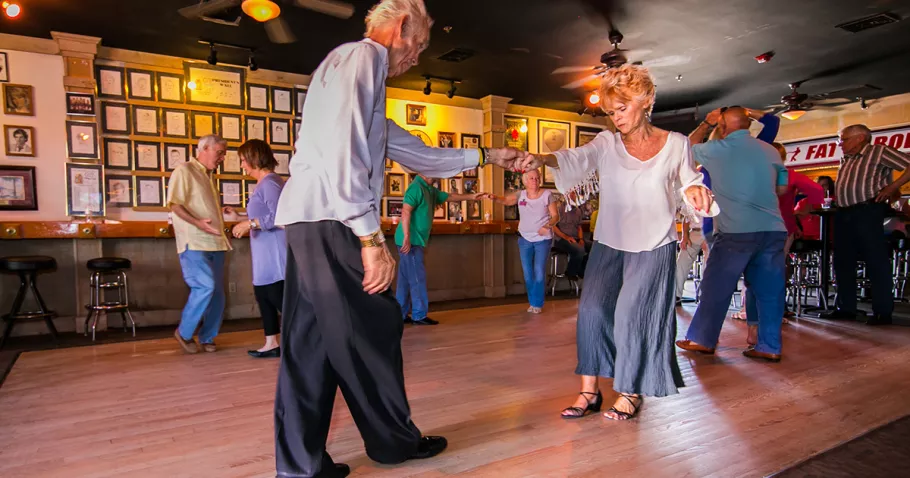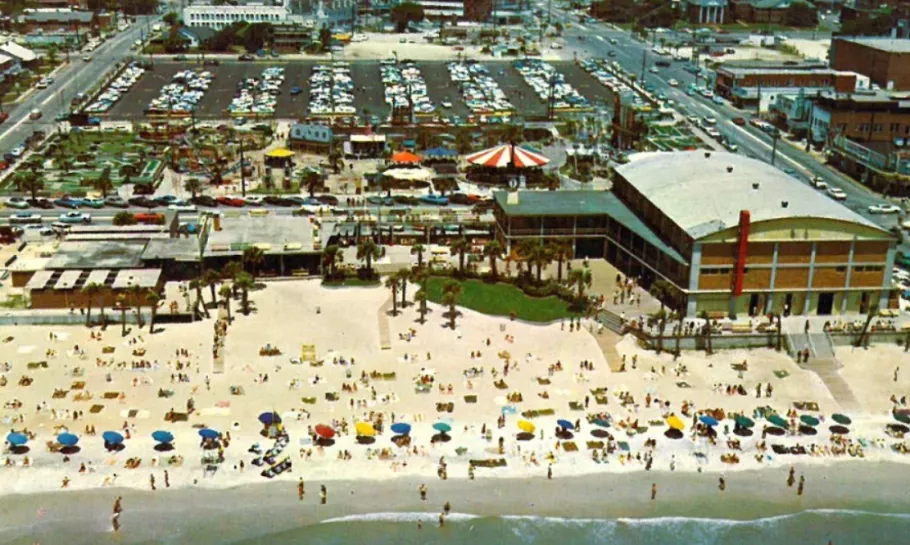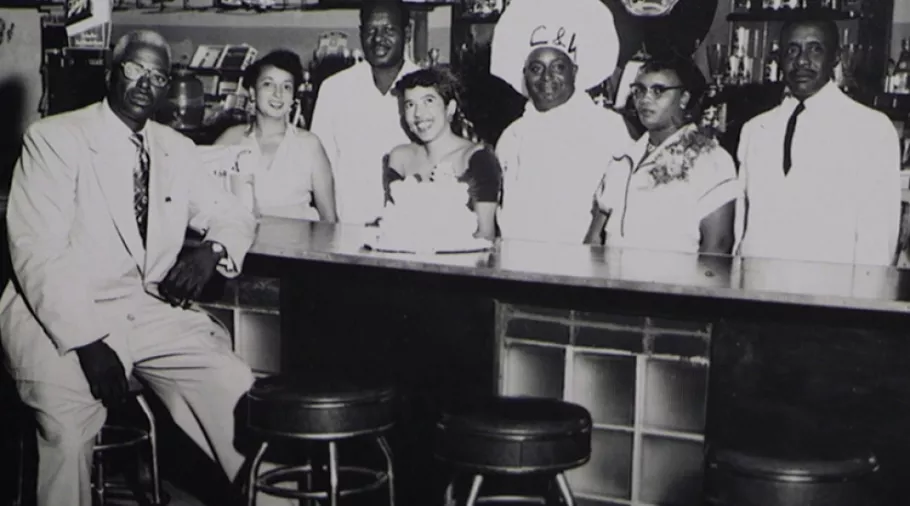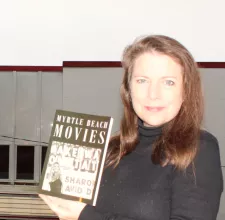Make Time to Shag!

For all of those who are knowledgeable about the origin of The Shag, the state dance of South Carolina since 1984, it is widely agreed that…no one agrees on the origin of The Shag! When I’m sharing its history with my guests, I tell them that I’m going to give them two popular theories, but that when we get to the Charlie’s Place historic site, formerly where a club that hosted the biggest names in twentieth century music was located in Myrtle Beach, they are going to hear a third.

The first theory is very specific. A dance instructor by the name of Lewis Philip Hall choreographed a new dance which he called The Shag and introduced it on August 22, 1928, at the 2nd Annual Feast of the Pirates Festival (there were only three festivals ever) in Wilmington, NC, for the 30,000 people in attendance. College students there took it back to their campuses and it caught on like wildfire. By the following summer, Virginia Beach declared itself "Shag Mad" because everyone there was crazy for the new dance. Throughout the 30s, shag contests were held, popular composers wrote songs about The Shag, and it went on from there.
The other theory is that The Shag is merely a slowed down version of the jitterbug. The local shaggers of the 40s and 50s never intended to invent a new dance, but the jerky movements of the jitterbug didn’t fit with the beach lifestyle. One veteran shagger explained that we began to dance the same way we talked to girls…nice and easy and real laid back.
In the Summer of 1950, a young woman who would give shag lessons at the Myrtle Beach Pavilion said that her mother, who was a dance teacher in Charleston, taught the old Lewis Philip Hall style, but she herself would teach the “get down and dig in the sand style like they would do at Spivey’s Pavilion.”
While the Myrtle Beach Pavilion, built in 1948, was the fourth of a series of pavilions, each constructed for entertainment, Spivey’s Pavilion was made out of an old tobacco warehouse that was brought in from a more western part of Horry County. It was located on what had traditionally been known as Spivey’s Beach which was around 2nd Avenue South across from where the Family Kingdom Amusement Park is now.
Spivey’s met its end on October 15th, 1954. It was washed away by Hurricane Hazel and was never rebuilt.

One of the most epic venues in Myrtle Beach for shag dancing is now a Dollar General on the corner of 20th Avenue North and Kings Highway. I remember back in the seventies when it started out as an Eckerd drug store. But in the Eighties and beyond, it was Studebaker’s. Legions of shag dancers, beach music enthusiasts, and others would flock to this club. In fact, it was the site of the first Shag National Championships in 1984.
In 1990, the actor Robert Duvall was a special guest at the competition. The year before, he had been filming Days of Thunder with Tom Cruise in Darlington, SC. Duvall, a tango enthusiast, learned how to shag at a little club in nearby Florence where they would hang out after a day of shooting. He fell in love with The Shag and made it a point to be at the next championship to watch it in person.
Back before they had such definitive competitions, the best shaggers in the forties and fifties brought the most popular dance steps to the Pavilion that they had picked up in Black-owned clubs like Charlie’s Place. Because of segregation, those White dancers were the ones relegated to the clubs’ upstairs balconies to prevent any racial mixing on the dancefloor. But Charlie’s Place was ahead of its time and its dance floor was integrated.
The best dance instructor at Charlie’s Place was the hostess, Cynthia Harrell. Her nickname was Shag. She would come down from New York during the season to work at the club. With her, she would bring the latest dance steps which she shared with the local teens. When the White kids would go back over to the Pavilion to show off what they had learned, their friends were impressed and asked where they had picked up the steps.
They would tell them that they had gone to Charlie’s Place to dance WITH Shag. But oral history suggests that there was a misunderstanding and the friends thought they had said that they went to Charlie’s Place to dance THE Shag.
That may be the origin of the third theory of how The Shag became our state dance. That is that The Shag originated at Charlie’s Place. On the historical marker on the street in front of the site it says in part that “Oral tradition holds that “the Shag,” a form of southern swing dancing, originated here.”
You can read the marker in its entirety when you visit Charlie’s Place. You can also see a picture of Shag. Go into the fourth room of what is a fabrication of the original motel units that share the site with Charlie and Sarah Fitzgerald’s original home and the lawn where the club used to be. There is a photo of Charlie and some of his staff at the club’s bar. Behind the birthday cake placed on that bar is a vibrant lady with a beautiful smile. That’s Shag.

At Charlie’s Place, I’m usually asked two questions by my guests: Where can we go to see people shagging and can I demonstrate the dance for them. Addressing the second inquiry first, the answer is no. I grew up in the seventies and eighties, what some term as the “Dark Ages of The Shag.”
Growing up, I never heard of The Shag. I listened to Beach Music, but it wasn’t called that. It was just the music on the radio. You danced to it anyway you wanted. Not until high school did I start hearing these terms. I graduated from high school in 1984, the same year Bill Number 3591 passed the state legislature stating:
Whereas, all South Carolinians are proud that the shag, one of the great developments in terpsichorean [relating to dancing derived from the name of classical mythology’s muse of dance, Terpsichore] culture, is native to this State, and Whereas, it is appropriate that the contributions that the shag makes to the cultural life of South Carolina, the United States, and the world should be recognized above all in the birthplace of the shag. Now, therefore, Be it enacted by the General Assembly of the State of South Carolina: Shag designated official state dance
As to where is the best place to go to see people shag, that would be Ocean Drive (known affectionately by its initials) in North Myrtle Beach. While The Shag, in these parts, began in Myrtle Beach, it is thought that when the Pavilion opened their live performance auditorium upstairs, the juke box was removed, and all of the shaggers migrated to O.D. Today, clubs like Fat Harold’s Beach Club (Fat Harolds Beach Club | North Myrtle Beach, SC) and Duck’s Nightlife (Ducks Night LIfe | Where Life Begins and Never Ends), among others, keep the love for our state dance going there.
A key entity that pulled The Shag through the “Dark Ages” is the Society of Standers (also affectionately known by their initials). S.O.S. is the umbrella organization for dozens of shag clubs all over both Carolinas and they host their three major gatherings in O.D., their Fall Migration, Mid-Winter and Spring Safari. Those along with the Shag National Championships are the most quintessential shag experiences that you can enjoy.
